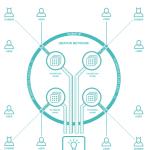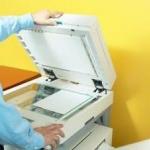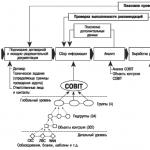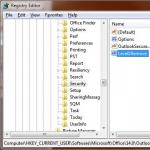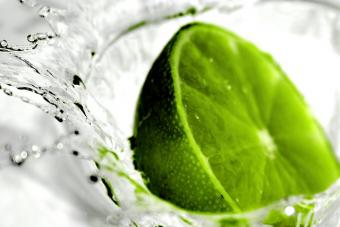Reflexotherapy (from the Latin reflexus - turned back, reflected) - a treatment system based on reflex relationships formed in the process of phylo- and ontogenesis, implemented through the central nervous system by irritating the receptor apparatus of the skin, mucous membranes and underlying tissues to affect the functional systems of the body .
Reflexology (RT) in ancient Chinese traditional medicine is denoted by the term "zhen-jiu". Zhen-Jiu therapy (or acupuncture, acupuncture) is a treatment method based on the impact of a thin needle on the biologically active points of the skin.
The classical method includes acupuncture (acupuncture) and moxibustion. In modern conditions, various methods are used using physical factors (electropuncture, laser acupuncture, pharmacopuncture, color therapy, flowering method, various reflexogenic massages).The first written information about acupuncture appeared a very long time ago and dates back to the period of 2400 years ago ("Huang Di Nei Jin").The method has proven to be an effective way to treat various diseases. In the treatment of Zhen-Jiu therapy, chemicals do not enter the body, i.e. it is an "environmentally friendly" method of treatment.
Zhenjiu therapy is a traditional branch of Chinese medicine dedicated to the prevention and treatment of diseases. Zhen-Jiu therapy, acting on the energy basis of the body, ensures the unity and orderliness of the work of various organs and systems, incl. determines the conjugation of the psyche with the physical body. This method of treatment allows you to eliminate the consequences of uncontrolled stress, achieve good health, increase the body's defenses.
Reflexology is basically a corrective treatment that controls various bodily functions. Therefore, it is effective only where these connections are changed, but not where they are completely destroyed. For acupuncture, an ancient Chinese proverb is true, which says: "Medicine cannot cure either old age or wilted flowers."
Indications and contraindications for the use of reflexology methods in medical practice
Diseases (syndromes) of the nervous system and sensory organs:
- diseases of the autonomic nervous system, idiopathic peripheral autonomic neuropathy (sympathoganglionitis, etc.);
- atypical facial pain;
- diseases of the facial nerve, diseases of other cranial nerves;
- diseases of the nerve roots and plexuses, limb phantom syndrome;
- mononeuritis of the extremities and multiple neuritis.
Mental disorders:
- neurotic disorders: anxiety neurosis (anxiety), neurotic phobias, hysterical neurosis, obsessional neurosis, neurotic depression, neurasthenia, hypochondriacal neurosis;
- frigidity and impotence;
- chronic alcoholism, substance abuse, tobacco smoking;
- violation of the physiological functions of psychogenic etiology (psychogenic torticollis);
- enuresis.
Diseases of the eye and its appendages:
- chronic conjunctivitis, blepharoconjunctivitis and blepharitis (allergic);
- optic neuritis (with a moderately pronounced decrease in vision);
- diseases (syndromes) of the ear and mastoid process;
- Meniere's disease;
- ringing in the ears, diseases of the auditory nerve, otalgia.
Diseases of the circulatory system:
- essential hypertension, hypertension (stages I and II);
- chronic ischemic heart disease (without pronounced changes in the ECG);
- atherosclerosis (early stages);
- syndrome (disease) Raynaud;
- varicose disease, trophic ulcers;
- hemorrhoids (external and internal);
- hypotension.
Diseases of the endocrine system, metabolic disorders:
- thyrotoxicosis (moderately pronounced);
- dysfunction of the ovaries and testicles (moderately pronounced).
Respiratory diseases:
- chronic rhinitis, pharyngitis, allergic rhinitis, chronic laryngotracheitis;
- chronic bronchitis, bronchial asthma.
Diseases (syndromes) of the digestive system:
- chronic gingivitis, paradontosis, stomatitis, glossodynia, glossalgia;
- peptic ulcer of the stomach and duodenum;
- gastritis and duodenitis, gastroenteritis and colitis of non-infectious etiology;
- dyspepsia and other functional disorders of the stomach;
- constipation;
- chronic non-calculous cholecystitis, biliary dyskinesia.
Diseases (syndromes) of the genitourinary system:
- chronic cystitis;
- vaginitis and vulvitis, cervicitis and endocervicitis;
- violation of the menstrual cycle, uterine bleeding, menopausal syndrome;
- childbirth and the postpartum period;
- regulation of labor activity and anesthesia of childbirth;
- lactation disorders.
Diseases (syndromes) of the skin and subcutaneous tissue:
- seborrheic dermatitis, eczema;
- itching and related conditions;
- urticaria, angioedema.
Diseases (syndromes) of the musculoskeletal system and connective tissue:
- rheumatoid arthritis (with dysfunction of the joints I-II stage);
- traumatic arthropathy, chronic post-traumatic arthropathy;
- deforming osteoarthritis and related disorders;
- allergic arthritis;
- diseases of the intervertebral discs (with various neurological disorders - radicular syndromes).
Relative indications of reflexology
- thyrotoxicosis with or without goiter;
- diabetes;
- hypothalamic syndromes without pronounced neuroendocrine, metabolic and neurotrophic disorders;
- gout;
- encephalitis, myelitis, encephalomyelitis, consequences of acute poliomyelitis;
- progressive muscular dystonia;
- shaking paralysis (Parkinson's disease);
- multiple sclerosis;
- cerebral palsy;
- epilepsy;
- syringomyelia;
- peripheral retinal degeneration, focal chorioretinitis and focal retinochoroiditis, acute and subacute iridocyclitis, vascular disorders of the iris and ciliary body;
- glaucoma (initial form, pain syndrome);
- otosclerosis;
- paroxysmal tachycardia, unspecified;
- transient ischemia of the brain, long-term consequences of cerebrovascular disease (with moderately severe dysfunction);
- pain syndromes in diseases of the gallbladder and biliary tract;
- chronic pancreatitis;
- pain syndromes in organic diseases of the genitourinary organs.
Reflexology contraindications
- benign and malignant neoplasms;
- diseases of the blood and blood-forming organs: hereditary hemolytic anemia, bleeding disorders, purpura and other hemorrhagic conditions;
- pregnancy;
- acute infectious diseases and febrile conditions of unknown etiology;
- chronic infectious diseases in the acute stage (tuberculosis, etc.);
- decompensated diseases of the heart, lungs and other internal organs;
- pneumosclerosis with a tendency to pulmonary bleeding;
- myocardial infarction;
- active rheumatism;
- venous thrombosis and embolism in the acute period;
- severe exhaustion;
- physical stress;
- frostbite and inflammation of the auricle;
- acute inflammatory processes of the musculoskeletal system;
- congenital malformations of the CNS.
In reflexology there is also reflex prophylaxis, with the help of which you can increase the natural defenses of the body and mobilize forces in the necessary conditions in a healthy person. Reflexology can increase adaptive reactions and prevent negative emotional breakdowns.
Years of experience shows that in about 20% of patients, acupuncture has no effect at all. In such patients, RT should be stopped completely or supplemented with other methods of treatment. The criterion for making such a decision should be the first 3 unsuccessful acupuncture sessions.
Reflexology- these are methods of physical influence on point areas of the body surface (acupuncture points). Due to this effect, an impulse arises, which is transmitted to the corresponding nerve centers, and they, in turn, transmit a signal to the affected organ, activating the self-healing system.
This method came to us from China. Its first descriptions date back to the 5th century BC. In the 17th century A.D. reflexology spread to Europe. At the beginning of the 20th century Dr. Fitzgerald created the basis of modern reflexology.
Reflexology is based on the idea of the body as a single interconnected system, and therefore a disturbance in one part of the system causes a disturbance in other parts. The main attention is paid to the energy structure of the human body, which consists of several energy systems.
During the session the doctor selectively affects the reflex zones, through which several energy systems pass at once, choosing the angle of impact, pressure force and duration. These energy systems interact with each other according to certain laws that determine the necessary methods of treatment and restoration of the body. Scientists noted that at these points, blood circulation and lymph flow are increased, oxygen is more actively absorbed, sensitivity to pressure is increased, and a number of other features.
Conventionally, the human body can be divided into 10 vertical zones running along the body. When a change occurs in one place in such a zone, the changes affect the entire zone.
Areas of application of reflexology very diverse: neuropathology, therapy, ophthalmology, dentistry, obstetrics, psychiatry, narcology, anesthesiology and others. It can be used in combination with medication and on its own.
Depending on the disease the following methods are used:
- Acupuncture (acupuncture, acupuncture).
- Manopressopuncture (shiatsu, acupressure).
- Vacuum pressopuncture (vacuum therapy, can massage).
- Applicopressopuncture (balloon therapy, application with balls and plates).
- Thermopuncture (cauterization, heating, chiu-therapy).
- Cryopuncture (cryotherapy).
- Electroacupuncture.
- Pharmacoacupuncture (administration of drugs through acupuncture points, injection reflexology).
- Magnetopuncture (magnetotherapy).
- Heliopuncture (infrared irradiation in the area of acupuncture points).
Also Reflexology is divided into areas of influence:
- Corporal (impact on acupuncture points on the surface of the body);
- Auricular (impact on the acupuncture points of the auricle);
- Cranial or scalp therapy (impact on acupuncture points in the head area);
- Nasotherapy (impact on acupuncture points in the nose area);
- Pedotherapy (impact on the acupuncture points of the feet), etc.
The most commonly used reflexology with disorders of the vegetative-vascular system, neuroses, sexual disorders of a psychogenic nature, enuresis, stuttering, neuralgia, consequences of cerebrovascular accident, traumatic brain injury, chronic alcoholism, smoking, obesity.
The advantage of reflexology is its safety. The main physiological functions of the body are not disturbed by acupuncture. However, the effect of using reflexology is very high and fast. This allows you to use this method even at home.
Methods that have been used since ancient times in the modern world are gaining new opportunities and are being re-evaluated by specialists and patients. Their effectiveness has been proven not only by time, but also by a mass of scientific studies.
What is reflexology
Under the name reflexology lies a healing system that originated in ancient China. Recognition in Europe came to her in the 17th century. On the territory of the former USSR, one of the methods of reflexology - acupuncture - was officially recognized in 1957 as a result of an exchange of experience with Chinese doctors. The most active use began in the 60s and was included in physiotherapeutic methods of treatment.
In medicine, reflexology is a complex of methods of point impact on certain parts of the body. When exposed to biologically active points, they are stimulated with the help of impulses. They, in turn, affect those parts of the brain that trigger the processes of autoregeneration in the affected organ.
What is the basis of the doctrine of reflexology
The human body and body is a single bioenergetic system. In case of violations in one part of it, the whole structure certainly suffers. Through research, points on the body were found that have special properties:
- increased sensitivity to pressure and the effects of electric current;
- increased uptake of oxygen;
- more active micro-circulation of blood and lymph.
Official medicine recognizes several methods of reflexology, which include treatment with acupuncture, metal balls, cigarettes from bitter wormwood, warm stones, electrodes, laser beams.
Reflexology is successfully used as an independent method of therapy and is combined with medical methods of treatment.
Reflexology indications
Reflexology is used in various fields of medicine: neuropathology, therapy, psychiatry, ophthalmology, dentistry, anesthesia, obstetrics, gynecology.
With osteochondrosis
A common disease that is caused by pathological processes in the joints and leads to their wear, loss of functionality, pain.
With the help of reflexology, it is possible to restore metabolic processes in the joints, normalize the composition and functions of the connective tissue.
With speech delay
SRR or delayed speech development in children is quite common. The reasons can be both mental and neurological disorders, and problems with the physiological development of the speech apparatus. In addition to speech therapy and psychological assistance to the child, experts often recommend resorting to some methods of reflexology. This allows you to painlessly and effectively influence the cause of the RRR.
With obesity
Obesity is rightfully referred to as the “plague” of the 21st century, and experts identify several reasons for the appearance of excessively high weight:
- psychological;
- hormonal.
In both the first and second cases, reflexology is highly effective, since the impact on the centers of the brain responsible for satiety and pleasure restore their work and a person does not have a desire to “eat” stress or associate food with the only source of pleasure.
In the case of obesity due to hormonal failure, with the help of reflexology, the work of the endocrine system is restored, on which most metabolic processes in the human body directly depend.
 Stimulation of points on the ear, on the upper lip under the nose, under the knee, and on the arm speeds up metabolism, reduces appetite, improves bowel function
Stimulation of points on the ear, on the upper lip under the nose, under the knee, and on the arm speeds up metabolism, reduces appetite, improves bowel function With cerebral palsy
Infantile central paralysis is a disease that can be caused by intrauterine development disorders - hypoxia, birth trauma, hemolytic disease of the newborn, acute or chronic diseases of the mother (obesity, rubella, hypertension, diabetes mellitus). Cerebral palsy manifests itself in the form of disorders of the brain, as a result of which pathologies of the musculoskeletal system develop. When using acupuncture, pharmacopuncture, specialists observe not only a weakening of the pronounced symptoms of the disease, but also a partial restoration of the work of the affected areas of the brain. In rare cases, almost to a complete cure.
With bronchial asthma
Bronchial asthma can result from an increased tendency to allergic reactions and is accompanied by difficulty breathing. Reflexology is able to increase the protective functions of the body and thus eliminate the cause of bronchial asthma.
 for shortness of breath and asthma, press on this point for a minute with your index finger
for shortness of breath and asthma, press on this point for a minute with your index finger Varieties of reflexology
This term is the general name of a large list of techniques that are built on the same principle. Since the essence of reflexology is the impact on active points on the human body, its varieties differ primarily in the way they influence:
- Acupressure or Shiatsu- stimulation of points occurs by pressing them in a certain way with a fingertip or special tools. The main advantage of acupressure is the impact without damaging the skin.
- Acupuncture- activation of points occurs when special needles are inserted, which are fixed in the body for a certain period of time. Tools are made of noble metals. This method also includes auriculotherapy - the activation of points located on the auricles with the help of acupuncture.
- Microcurrent therapy- designed to restore the functioning of the musculoskeletal system. The reflexologist stimulates active points on the feet, establishing the transmission of impulses to the cerebral cortex. The method is effective for IRR and cerebral palsy in children, as well as diseases of the musculoskeletal system of a different nature in adults.
- Pharmacopuncture- the introduction of pharmaceutical and homeopathic medicines with the help of acupuncture.
- Thermopuncture- stimulation of active points by heating them.
- Apipuncture- point impact on nerve endings through bee stings.
- Laser reflexology- effective in the treatment of infectious diseases, inflammatory processes, degenerative and dystrophic processes in tissues and post-traumatic syndrome. Another area of application of point laser therapy is hardware cosmetology.
- Vacuum pressopuncture- the use of special cans and devices to stimulate points on the skin by creating a vacuum.
- Cryopuncture– influence on points by extremely low temperatures.
- Magnetopuncture- the use of a magnetic field with a certain frequency on biologically active points in order to influence the state of the human biomagnetic field.
- Heliopuncture- exposure using infrared radiation with a given wavelength.
Good evening. Today I will introduce you (who still does not know what it is) to such a medical term as reflexology. From today's article, you will learn what it is, and also when it is used, how often it can be prescribed by doctors - this post is about all this.
What is reflexology, how does it affect the body
In neurology, reflexology has been used for a long time and rightfully has well-proven methods of treatment.
In fact, this is a medical specialty that involves knowledge and skills in the treatment of chronic and sluggish diseases.
Reflexology has a wide variety of therapeutic techniques and methods of influencing reflexogenic zones with the help of acupuncture, acupressure or cauterization. What specific method of treatment is suitable for a particular disease, only a doctor can determine.
How does it affect the body
In the process of reflexology sessions, the doctor, acting on certain, necessary points on the patient's body, starts the mechanism for restoring the neuro-reflex regulation of the body.
The result of such an impact is what is activated:
- central nervous system
- endocrine system
- neurohumoral system
- the immune system
- vascular system
And already thanks to this activation, the work of all organs is normalized, as well as the overall working capacity increases, the patient's sleep and his mood noticeably improve, the patient forgets about the headaches that tormented him earlier.
After a course of reflexology, many people simply choke, share their impressions with complete delight and tell everyone they know about their unprecedented cheerfulness. It can be summed up in two words – born again!
But do not think that this is a panacea for all diseases. Of course, this is far from true. It's just that reflexology courses are simply necessary for almost every patient at the stage of the early recovery period, after an illness.
The frequency of prescribing courses of reflexology and its effectiveness

In general, neurologists prescribe courses of reflexology quite often. This is due to the excellent results from its use in diseases of the nervous system and a positive effect on the body.
A variety of methods allow you to influence all organs and systems of the human body, while using the hidden reserves of the body, which many have heard of and which every patient has.
Treatment has many effects, including:
- anesthetic
- anti-inflammatory
- immunomodulatory effect
- autonomic functions are normalized
- metabolism
- treatment has a calming effect
- increases efficiency
The main and main advantages of reflexology are its fairly simple technical support, the complete absence of adverse reactions, including allergic ones.
Acupuncture methods can complement or even replace other types of treatment and even the use of pharmaceutical drugs.
What neurological diseases is it used for?
Reflexology in neurology is used in the treatment of many different diseases. Among them:
- pain syndrome treatment
- sleep disorders
- neuroses
- neurological manifestations of osteochondrosis of the spine ()
- treatment of consequences of traumatic brain injury
- peripheral neuropathies
- cerebral palsy
- logoneuroses
- and etc.
There are also contraindications. For example, it is contraindicated to conduct courses of reflexology for tumor neoplasms, mental illness, individual intolerance, and also if the patient is over 80 years old.
How long does the course of treatment last and how likely is a positive result

The course of reflexology always consists of 10 procedures, which are prescribed daily or every other day. If re-treatment is required, then it is carried out after 4 to 6 months.
The result of acupuncture depends on the professional and competent preparation of an acupuncture prescription and the accuracy of determining the localization of acupuncture points, the technique of placing needles, and the experience of the therapist.
In addition to simple acupuncture, micro acupuncture is also used. It is designed for prolonged exposure to certain points.
Microneedles are usually inserted after a course of classical acupuncture from 1-2 to 7 days. This alternation continues throughout the course. Periodic pressure on the microneedles irritates the point and can prevent seizures and relapses in certain diseases, and also reinforces the therapeutic effect of acupuncture therapy.
On average, it takes 3-4 hours to write 1 article. By sharing the article in social networks, you express gratitude to the authors of the blog for their work!!!Reflexology is one of the oldest methods of relaxation and restoration of the human body. It is based on the understanding that there are more than 800 active points on the human body, the impact on which allows you to stimulate the work of certain organs, which means it helps in the treatment of various diseases.
China is considered the birthplace of this medical complex, because the first mention of acupressure was found in ancient Chinese writings dating back to the 5th century BC. Europeans learned about this trend in medicine only in the 17th century, but reflexology in its current form arose only at the dawn of the 20th century. This happened thanks to the scientist William Fitzgerald, who noticed that massaging certain points on the arms and legs allows you to relieve pain, improve organ function and achieve a state of relaxation. It was Fitzgerald who developed the basis of modern reflexology, the benefits of which we can get in various medical centers and SPA-salons.
Indeed, modern medical centers are ready to offer several methods of reflexology at once, among which the most popular are acupuncture (acupuncture and acupuncture), thermopuncture (heating and cauterization), electroacupuncture, cryopuncture, magnetopuncture, as well as vacuum pressopuncture (cup massage) and monopressopuncture (spot massage). massage). Each of these methods has proven to be an effective means of relaxing and restoring the body. Their only disadvantages are that only highly qualified specialists in the conditions of medical centers can carry out such procedures. And the cost of sessions of such treatment is quite high, which makes reflexology inaccessible to low-income segments of the population. The only exception is monopressopuncture, which we all know as acupressure. Each of us can carry out such a procedure, it is enough just to know which points on the body are associated with a particular organ, and how to influence them correctly.
First of all, let's talk about the methods of influence. As a rule, pressure, rubbing, direct or circular stroking is applied for 2-3 minutes. On areas in which there is no pain, you can apply quick and sharp pressure, as well as massaging counterclockwise. As for the points, touching which causes pain, uniform pressure is applied to them until the discomfort disappears. If massage is applied to such points in circular motions, then it is carried out clockwise, in order to “start” the energy.
Now let's go directly to the diseases, in the treatment of which this method of alternative medicine helps.

1. Diseases of the digestive system
If you suffer from digestive problems, suffer from dyspepsia, regularly experience flatulence and stomach cramps, you should massage the center of the palm of your left hand. It is here that the area is located, which helps to activate the work of the stomach and intestines, removing the existing discomfort. In case of constipation, an active circular action in a clockwise direction is recommended, and in case of diarrhea, gentle pressure and rubbing in a counterclockwise direction are recommended. In case of problems with the liver, it is necessary to regularly massage the central part of the palm of the right hand or the areas on the soles of the feet, marked in diagram No. 2 in red.
By the way, under the liver zone on the right leg, you can find a point that stimulates the gallbladder. Daily active influence on this area helps in the fight against cholecystitis and gallstone disease.
2. Insomnia
Many people treat such an ailment with disdain, believing that it is somehow not serious to contact doctors with sleep problems. In fact, insomnia is a serious disease that seriously affects the quality of life and interferes with the normal functioning of all organs and systems in the body. Turning to a doctor with such a problem, the patient most often receives a prescription for a sleeping pill, as well as recommendations for establishing a work and rest regime, avoiding stress and proper nutrition. However, this does not prevent you from helping yourself to establish sleep with the help of reflexology. This is done quite simply, you just need to massage the points located under the heels, as well as under the little fingers of each of the legs every day. It will also benefit from massage of the hands, in particular, the pads on the fingers, due to which the pineal gland is activated, which produces the hormone melatonin, which improves sleep.
3. Hypertension
It is no secret that it is with hypertension that the most dangerous diseases begin, threatening a person with a fatal outcome. High blood pressure leads to heart failure and causes critical conditions such as stroke or heart attack. Yes, and in itself, hypertension is accompanied by a severe headache, weakness and malaise, which seriously impairs the quality of life. To normalize pressure and prevent deterioration of health, you can use acupressure, aimed at improving the functioning of the diaphragm and lungs. In this regard, you should massage the areas on the palms located under the fingers. This should be done by reciprocating movements of the thumb of the other hand or by rubbing the palms. A good help in lowering blood pressure will also be a massage of the zones responsible for the adrenal glands, which are designed to regulate the activity of the circulatory system. Here you should also pay attention to the middle of the feet, where special points are located (scheme No. 2).
One has only to add that in parallel with a massage aimed at normalizing pressure, it is necessary to stimulate the brain and eyes, that is, the organs that suffer from hypertension. To get rid of pain in the eyes, you will need a light massage of the base of the little finger on both hands, as well as stimulation of the points under the toes.
4. Nausea
Nausea is not a disease, but a very unpleasant symptom, which is accompanied by weakness, sweating and often precedes vomiting. Sometimes this is a signal from the body that it wants to get rid of poisonous substances that poison it. In this case, it makes no sense to fight nausea, it is better to help free the intestines from harmful elements. However, medicine knows more than a dozen diseases that are accompanied by nausea. In these cases, it is necessary to look for a way to deal with such a condition. Fortunately, acupressure helps in this case, it is enough to find the points that are responsible for the stomach and intestines. They are located in the center of the left palm, as well as on the narrowing of the soles of both feet. It is better to massage them by pressing or stroking clockwise.
In addition, to get rid of the painful feeling of nausea, one should massage the pads of the fingers, thereby stimulating the brain, which in turn will reduce the excitation of the vomiting center.
5. Depression
The most common mental disorder in our time is depression. It negatively affects our mood and mental abilities, and also provokes physiological problems such as headaches, diarrhea or hormonal imbalances. Moreover, depression can lead a person to suicide if the disease is not recognized and treated in time. Of course, reflexology will not help you get rid of depression, only qualified psychotherapists can do it, but such a procedure is quite capable of helping to normalize the condition and restore peace of mind. As with many other diseases, it is important to influence the brain in order to regulate the functioning of the nervous system through this organ. To do this, every day massage the tops of the toes, as well as the pads of the fingers on the hands. This will contribute to the production of serotonin, which will most positively affect your mood.
6. Endocrine diseases
Diseases of the endocrine system, in particular, thyrotoxicosis or goiter of the thyroid gland, require serious medical treatment and long-term replacement therapy prescribed by a doctor. In turn, acupressure of zones that activate the activity of the endocrine glands, including the "thyroid gland", becomes an excellent help in the treatment of these diseases. Each person who has encountered such problems can help himself if he regularly massages the point at the base of the thumb (see diagram No. 3), as well as the areas on the soles that go from the big toe to the instep. Massage these areas should be rotational or reciprocating movements.
7. Menstrual pain
Millions of women around the world from month to month experience this unpleasant condition during menstruation. Moreover, for some of the fair sex, menstrual pains are so intense that they have to resort to strong analgesics. And this is not only a serious burden on the liver, but also a decrease in immunity. But is there an alternative to painkillers? And here acupressure can come to the rescue, namely, stimulation of the ovaries and uterus. You can find these points on the palms, just below the middle, as well as on the wrist (see diagram No. 3).
You can also fight menstrual pain by affecting the brain, namely the pineal gland and pituitary gland, which relax the muscles of the uterus and remove the existing discomfort. To stimulate the pituitary gland and the pineal gland, you need to actively massage the plantar part of the big toe of one and the other foot. It is better to massage in a circular motion counterclockwise.
8. Osteoarthritis and rheumatoid arthritis
Joint diseases often bother older people. Every person who has had a chance to deal with rheumatoid arthritis or osteoarthritis knows that the aching pain that accompanies the exacerbation of these ailments simply drives you crazy, preventing you from falling asleep and interfering with your daily activities. Moreover, injections, ointments or tablets bring only temporary relief. Can acupressure help here? Undoubtedly. To get rid of pain, you should massage the area located under the little fingers, which will help relieve discomfort in the arms and shoulders, as well as the area under the little finger on the left leg. And people who have knee pain and discomfort in the pelvic area require regular massage of the areas on the outside of the soles of both feet (highlighted in red in diagram No. 2).
In addition, stimulation of the adrenal glands helps to eliminate the pain caused by rheumatoid arthritis, for which it is necessary to press intensively on the points located in the center of the feet. Such massage will improve the secretion of corticosteroid hormones, due to which the inflammatory process will decrease.

9. Diseases of the spine
People of middle and older age are familiar with diseases of the spine, such as osteochondrosis, sciatica, or intervertebral hernia. Persons with such problems suffer from constant aching pains, and are forced to take medicines in handfuls to alleviate their condition. However, reflexology can also be of great help here. Pay attention to the scheme number 3. Here you can see that the points responsible for a particular section of the spine are located along the thumbs of both hands. For example, the first phalanx of the finger is connected with the cervical spine, the second phalanx is connected with the thoracic region, and the area from the wrist to the beginning of the second phalanx is responsible for the lumbar region. Depending on which area of the spine gives you discomfort, you can massage specific areas of the hands to help relieve pain. One has only to remember that it is necessary to act on such zones carefully, slightly pressing or massaging the zones with rotational movements in a clockwise direction.
10. Male sexual problems
With the problem of male impotence, you should immediately contact a specialist. However, here, acupressure can be a great help in treatment. For example, if the cause of the disease lies in prostatitis, in addition to taking medications and prostate massage, it can be recommended to stimulate the point on the wrist of the left hand, which is responsible for this organ (see diagram No. 3). It is advisable to lightly press on the acupressure point or make circular massaging movements in any direction. In addition, foot massage helps to cope with male impotence, namely the areas under the heels that actively affect both the male genital organs and the nervous system, with a failure in which this disease most often begins. Take care of yourself!
